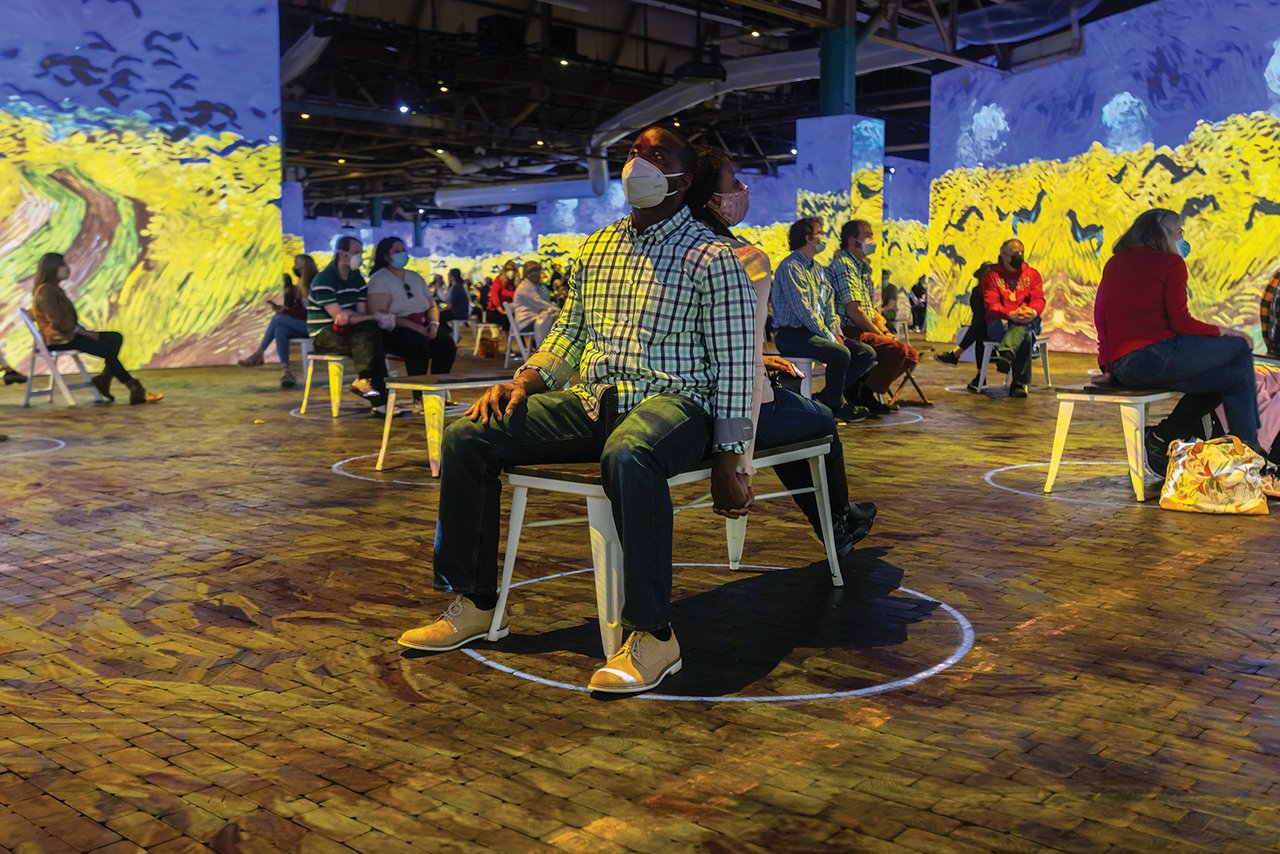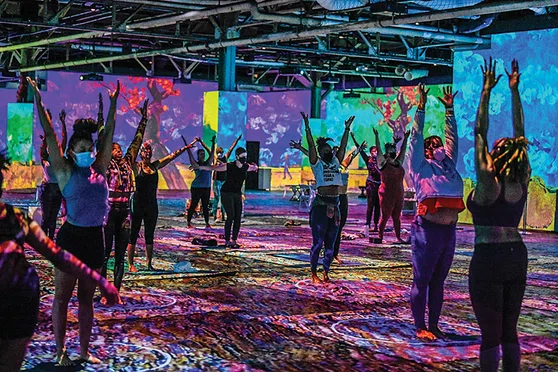

Blumenthal Performing Arts
IGNITING CULTURE
Winter 2021-22


Wild for Vincent
Charlotte Goes Gaga for 'Immersive Van Gogh'

Photo by Brian Twitty
Guests take in the "Immersive Van Gogh Exhibit."
by Page Leggett
What if Blumenthal Performing Arts threw a party – and everyone came?
That’s sort of what happened with the "Immersive Van Gogh Exhibit." When the global blockbuster opened at Camp North End last June, it was a gamble. COVID-19 hadn’t gone anywhere, and people were tentative – maybe even hesitant – about getting “back out there” again.
They could have stayed home, but they came in droves. Many came multiple times. At least four couples got engaged at the exhibit.
And the guest of honor at this nonstop art fest was an unlikely hero: Vincent Van Gogh (1853-1890). He didn’t achieve success in his lifetime, but look at him now! He’s a star.
In the middle of the COVID outbreak, the Blumenthal team took a $5 million risk and invested in bringing this immersive experience to Charlotte.
Its resounding success has set the stage for what Blumenthal wants to do more of: pair internationally known, iconic artists with talented, local artists, said Tom Gabbard, Blumenthal’s president and CEO. The idea is to bring people in to learn more about an artist they already love, and introduce them to real, local artists whose work they can buy and collect.
For the "Immersive Van Gogh Exhibit," Blumenthal brought in local artists to help decorate the space, do live paintings and display and sell their wares along with other merchants in the expansive gift shop.

Photo by Bae Hart
A yoga class is conducted at "Immersive Van Gogh."
Blumenthal also programmed the space to offer something for everyone:
Slam poets and rappers were involved with Rap Van Gogh events.
“Relaxed” performances allowed people who aren’t ordinarily comfortable coming to the theater to be part of something special.
Yogis could take immersive yoga classes against a changing backdrop of sunflower fields and swaying trees.
I think it’s useful to understand how quickly our team acted to put this together. Literally, from the time we said ‘Yes, let’s do it’ to the first audience showing up was four months. And everything our team did to make this happen was compounded by the pandemic.
— Tom Gabbard, Blumenthal Performing Arts president
Success story
The success (more than 280,000 tickets sold and local economic impact estimated at more than $36 million) could make you forget what a risk this was for Team Blumenthal.
“I think it’s useful to understand how quickly our team acted to put this together,” said Gabbard. “Literally, from the time we said ‘Yes, let’s do it’ to the first audience showing up was four months. And everything our team did to make this happen was compounded by the pandemic. Meetings with our Canadian partners and the artistic team in Italy were all done over Zoom. Historically, with a project like this, there would be multiple site visits.
“It represents a really good case study for nonprofits,” Gabbard continued. “And, for boards. I give a lot of credit to our board. They were ready to greenlight this at the height of the pandemic. The goals were simply to get people back to work and get audiences comfortable with attending events indoors again. We also needed to manage our financial risk since we had lost millions of dollars during the shutdown. Over 200 people were employed, many who had been unemployed since the events business shutdown. Audiences returned and helped set the stage for indoor shows to start up in September.”
Uncle Sam helped too. “Fortunately,” Gabbard said, “we were the beneficiaries of a federal grant called Shuttered Venues Operating Grants, which made it possible for Blumenthal and others across the country to reactivate during 2021 and not just sit on the sidelines.”
When did Gabbard first know the gamble had paid off? It was the day in March when tickets went on sale. Van Goghers bought more than $1 million in tickets that first day.
People were ready to experience art again – and Blumenthal provided a way for us to re-engage ... safely. The vastness of Camp North End allowed for social distancing.
Photo by Brian Twitty
A sunflower/tire decoration makes for a good photo op at "Immersive Van Gogh."
A total immersion
“We set out to make the experience surrounding it extraordinary too,” Gabbard said. “I expressed to our team that I wanted the things surrounding the digital art to be worth the price of admission so that people, even before they’ve gone in, feel like they've gotten their money’s worth. And thanks to the hard work of Bree Stallings and others, we created things around the digital art that are quite extraordinary, and that was unique to Charlotte.”
Stallings, Blumenthal’s director of artistic experiences, joined the company in late March and immediately became consumed with Van Gogh.
“Several of us saw the show in Chicago (at Lighthouse ArtSpace at Germania Club),” she said. “That venue is as different as it can be from Camp North End’s Ford building. They have a very posh, white, modern building, and the Ford building is industrial but with a lot of character. It posed an interesting creative challenge.
“The artists-in-residence program they have in other cities – we put it on steroids,” she said. “We have local artists who’ve made things that are being sold in other cities – and generating fairly substantial revenues for them. It is putting money in the pockets of artists who need it, and the acknowledgement of their work is something extraordinary for them and for us.”
Stallings gave the artists plenty of creative freedom but still gave them guidelines.
“I wasn’t trying to get artists to imitate Van Gogh’s style,” she said. “I wanted people to pick up on a few things that I think are the emotive qualities of his work – color, extreme texture and a connection to a mental health journey.”
Van Gogh not only has an instantly recognizable style; his mental health struggles are also widely known. The singer/songwriter Don McLean wrote “Vincent,” a musical tribute to the tortured, often impoverished artist. It includes the line, “How you suffered for your sanity.”
“Some artists used all three, and some just one,” Stallings added. “I wasn’t necessarily asking people to be iterative of his style, because I think we have a lot more to offer than that. But it's been really sweet to see how easy it was for artists to run with an idea based just on one or more of those tenets as a prompt.”
Matthew and Liz from Winston-Salem get engaged at "Immersive Van Gogh" in July.
No one needed a prompt to use Van Gogh as a backdrop for date night, family night out, girls’ night out, boys’ night out, family reunions and … marriage proposals.
Not only that, another Blumenthal art installation provided a beautiful, whimsical setting for tying the knot. In October, “Intrude,” Amanda Parer Studio’s public art installation of 12 giant, inflatable bunnies that light up at night seemed to be the perfect place for some to say “I do.”
“When the bunnies arrived, we ended up having three weddings that happened out among them,” Gabbard said. “We’ve become a full-service wedding business; you can propose at Van Gogh and get married with the bunnies.”
Alyssa Lilley's was granted a wish to give her mother, above, who is battling lymphoma, a private viewing of the "Immersive Van Gogh Exhibit."
Once is not enough
More than 4,400 Van Goghers found the experience so special that they returned again and again.
Alyssa Lilley of Charlotte attended three times “and it still didn’t feel like enough to take it all in,” she said.
“I kept coming back because I’ve loved Van Gogh’s art my whole life,” she said. “Being inside the exhibit, seeing his work come to life made me feel like I got a glimpse inside his mind. I’ve read the books and watched the documentaries … but this made me feel it all more viscerally. It took out the narrative of others and let his artwork speak for him.”
Here’s the message she sent via Instagram:
"… My mother is currently battling Stage 4 lymphoma. She is a huge fan of Van Gogh’s work and has been vicariously living through my magical experience at the immersive event. Unfortunately, due to her condition on top of COVID, she is incapable to be in public, or even spend time with family including my sister’s newborn (her first grandchild.) As you can imagine, it’s been a very trying time.“I was hoping there was some way (to) allow her to come after or before hours for a short period ... She’s always been my biggest supporter, and doing something like this for her would help me pay it back …”
Paying it forward
"Immersive Van Gogh" seemed the right event at the right time – a wise risk to take. Not only did the experience wow the masses, but it was a shot in the arm for artists too.
“We hired 28 local artists to help us activate the space,” Stallings said. “There have been over 34 local artists (represented) in the shop, and we've had 13 artists-in-residence so far.” (There was another handful since the show was extended until Jan. 2, 2022.)
With a portion of each ticket going back into the creative community, Stallings said Blumenthal has returned about $400,000 – and counting – back to the creative community.
The fact that an artist who struggled to sell his work during his lifetime has spurred dozens of artists to make a living selling their Van Gogh-inspired art is a beautiful and terrible irony.
No doubt about it – the world, including our corner of it, can’t get enough of Vincent. ◼
Sharing the Love: Blumenthal’s Art-doption Program
Photo by Brian Twitty
The hand-painted picnic table at the "Immersive Van Gogh Exhibit" is among the items that will be put to use elsewhere when the show ends.
What happens to all the art when a show like "Immersive Van Gogh" is over?
Thanks to the Blumenthal Performing Arts’ Art-doption Program, it lives on in a new location.
Bree Stallings, Blumenthal’s director of artistic experiences, said that sculptures and the picnic tables local artists painted in response to their favorite Van Gogh pieces are obvious works that deserve a second chance in a new home. But there are less obvious works getting new life as well.
“One collaborative partner we are excited about receiving some of these items is Sam Fleming, executive director of 100 Gardens,” Stallings said. 100 Gardens is a nonprofit that implements aquaponics programs in schools, institutions and in communities of need.
The picnic tables will be put to use in their jail aquaponics training program. But they’re also getting some art that’s being repurposed. “The vinyl from a (directional) banner will be used in the garden beds of the program,” Stallings said.
“All of those things help relieve the financial burden of other nonprofit organizations while also infusing some art in places that might not otherwise receive them.” ◼
Goghing Up, Up and Away
To celebrate the record-breaking "Immersive Van Gogh Exhibit" at Camp North End, Blumenthal Performing Arts partnered with Lighthouse Immersive to bring the Vincent Van Gogh hot air balloon to Charlotte.
Close to 200 people gathered at Ballantyne’s Backyard Dec. 7 to watch crews inflate, fly and deflate the massive balloon.
Manning the basket was veteran hot air balloon pilot Bennett Schwontkowski of Midwest Balloon Adventures, who has flown in over 40 states since 1974. As a commercially licensed pilot, he has logged over 3,200 flights, including at the Kentucky Derby Festival and the 1988 Calgary Winter Olympics.
Photos by Brian Twitty





